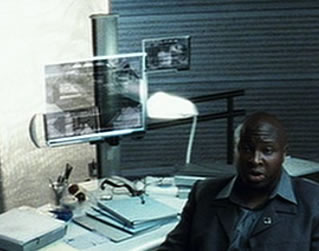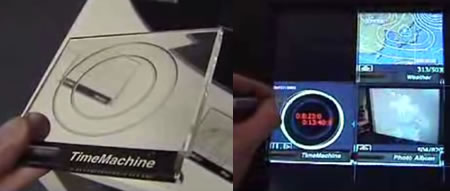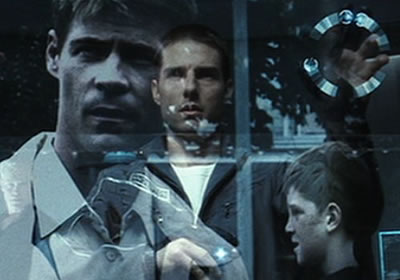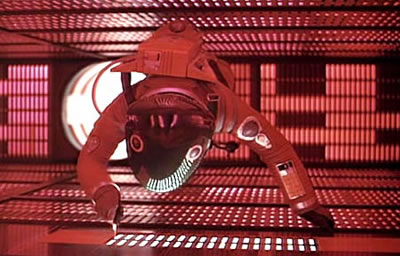Science Fiction
Dictionary
A B C D E F G H I J K L M N O P Q R S T U V W X Y Z
Sony DataTiles Inspired By What SF Movie?

Sony DataTiles have resurfaced, thanks to YouTube. In the video shown below, the DataTiles from Sony's Computer Science Laboratories show their stuff. Jun Rekimoto, Brygg Ullmer and Haruo Oba wrote the original paper describing the DataTiles as "A Modular Platform for Mixed Physical and
Graphical Interactions."
(Sony DataTiles in action)
The DataTiles use the following ideas about the way people interact with computers and data:
- Tagged transparent objects as graspable interaction modules.
It uses transparent acrylic tiles to serve both as physical windows for digital information and to trigger specific actions (e.g., launch an application, or submit a query) when placed on a sensor-enhanced display surface. - Mixed visual and physical interactions.
Users can interact with the information displayed by DataTiles using a pen or mouse. In addition to normal GUI interactions (e.g., mouse operations and widget operations), several combinations of physical and graphical interfaces are possible. For example, a printed high-resolution image (on a tile) can be visually fused with dynamic displayed graphics. Grooves engraved upon the tile surfaces also act as passive haptic guides of pen operations. - Physical language for combining multiple tiles.
Following a simple “tile language,” the placement of several tiles can compose a kind of 'sentence.' In this way, relatively simple combinations of tiles can express computational behaviors and functions.

(Data tiles from Minority Report, 2002)
In the Sony DataTile video, a tile called the TimeMachine can be placed next to other tiles, in this case a weather forecast and a video. Rotating the "dial" on the TimeMachine tile causes the others to move.

(DataTile user rotates TimeMachine)
In Minority Report, Tom Cruise does exactly the same thing, but with the large screen. He uses his glove to conjure up a circular control; as he "dials" it, the video of the father and son in the foreground goes back and forth over time.

(Note "dial" in upper right - moves through father/son images)
However, if you guessed Minority Report as the inspiration for DataTiles, you're wrong. Sony's DataTiles date from 2001, if not a bit earlier. Minority Report was screened in 2002.
It turns out that the creators of Sony DataTiles directly credit 2001: A Space Odyssey, by Stanley Kubrick and Arthur C. Clarke:
"Our inspiration for using transparent tiles as interface devices came from the film “2001: A Space Odyssey”, where the memory of the computer “HAL” was stored in transparent rectangular slabs."

(HAL 9000 undergoes memory modification)
Take a look at more real-world technologies related to the Minority Report movie and 2001: A Space Odyssey. Read more about the Sony DataTiles in DataTiles: A Modular Platform for Mixed Physical and Graphical Interactions.
Scroll down for more stories in the same category. (Story submitted 4/8/2007)
Follow this kind of news @Technovelgy.| Email | RSS | Blog It | Stumble | del.icio.us | Digg | Reddit |
Would
you like to contribute a story tip?
It's easy:
Get the URL of the story, and the related sf author, and add
it here.
Comment/Join discussion ( 1 )
Related News Stories - (" Display ")
iPhone Air Fulfils Jobs' Promise From 2007 - A Giant Screen!
'... oblongs were all over the floor and surfaces.' - Kazuo Ishiguro, 2021.
Transparent 4K OLED Wireless TV From LG
You will note that HG Wells also figured out the aspect ratio of the future!
DOTPad Braille Device Offers Live Access
Amazing tactile display.
Transparent MicroLED Screen From Samsung
Has Samsung nailed the Look of Things To Come?
Technovelgy (that's tech-novel-gee!) is devoted to the creative science inventions and ideas of sf authors. Look for the Invention Category that interests you, the Glossary, the Invention Timeline, or see what's New.
Science Fiction
Timeline
1600-1899
1900-1939
1940's 1950's
1960's 1970's
1980's 1990's
2000's 2010's
Current News
Wearable Artificial Fabric Muscles
'It is remarkable that the long leverages of their machines are in most cases actuated by a sort of sham musculature...'
BrainBridge Actual Transplant Of Human Head Proposed
'Briquet’s head seemed to think that to find and attach a new body to her head was as easy as to fit and sew a new dress.'
Google's Nano Banana Pro Presents Handwritten Math Solutions
'...copy was turned out in a charming and entirely feminine handwriting.'
Edible Meat-Like Fungus Like Barbara Hambly's Slunch?
'It was almost unheard of for slunch to spread that fast...'
Sunday Robotics 'Memo' Bot Has Unique Training Glove
'He then started hand movements of definite pattern...'
Woman Marries Computer, Vonnegut's Dream Comes True
'Men are made of protoplasm... Lasts forever.'
Natural Gait With Prosthetic Connected To Nervous System
'The leg was to function, in a way, as a servo-mechanism operated by Larry’s brain...'
Spidery 'Walk Me' Toyota Autonomous Wheel Chair Like Star Wars
Walk along with the emperor.
Dancing Robots Taught Dance Moves
'A clockwork figure would be the thing for you...'
Proof Of Robothood - Not A Person
'Who are you people? - Show 'em.'
Indonesian Clans Battle
'The observation vehicle was of that peculiar variety used in conveying a large number of people across rough terrain.'
The 'Last Mile' In China Crowded With Delivery Robots
Yes, it's a delivery robot. On wheels.
Tornyol Microdrone Kills Mosquitoes
'The real border was defended by... a swarm of quasi-independent aerostats.'
PLATO Spacecraft, Hunter Of Habitable Planets, Now Ready
'I ... set my automatic astronomical instruments to searching for a habitable planet.'
Factory Humanoid Robots Built By Humanoid Robots
'...haven't you a section of the factory where only robot labor is employed?'
iPhone Air Fulfils Jobs' Promise From 2007 - A Giant Screen!
'... oblongs were all over the floor and surfaces.'
